This is not a watch. Well, not just a watch. It can track heart rate. And it’s not even pink. Well, rose gold, perhaps.
One of the benefits about being a woman attending CES is that there are no lines in the loos. The men’s rooms, however, are, shall we say, over-subscribed due to the big disparity between the number of male attendees versus females.
Clearly, women are under-represented in technology companies at all levels, as the ladies’ room observation and many other more statistical reports recognize.
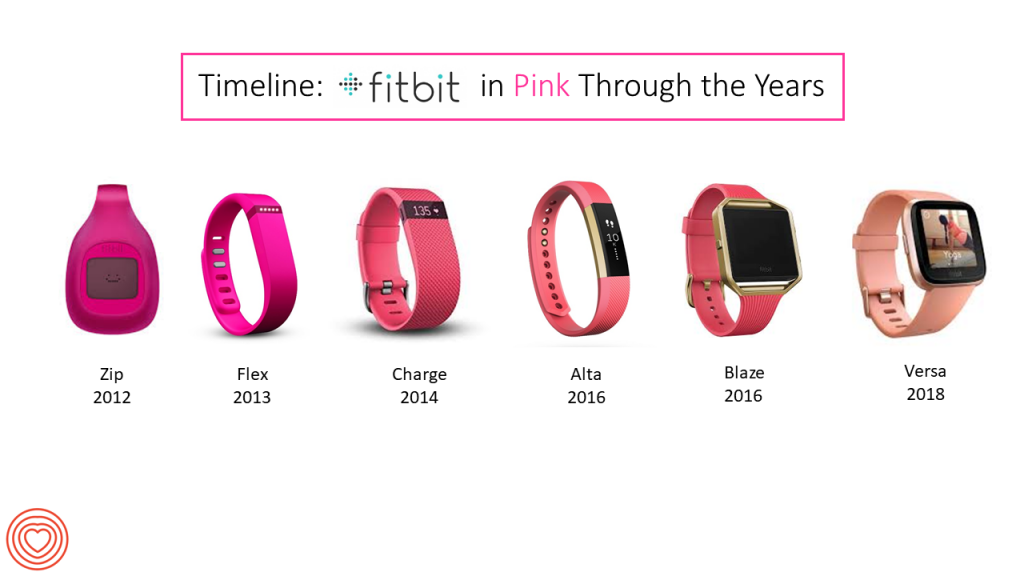 But I’ve good news to report on the product front about women-focused consumer technology at #CES2019: there’s a lot more of it, and some of it very meaningful, impactful, and quality-of-life enhancing. I assert this through my health lens, as well as health-economic perspective.
But I’ve good news to report on the product front about women-focused consumer technology at #CES2019: there’s a lot more of it, and some of it very meaningful, impactful, and quality-of-life enhancing. I assert this through my health lens, as well as health-economic perspective.
Start with Fitbit, among the most mature digital health suppliers featured at CES over time. Here’s a slide I developed when the Versa came to market, where I curated pink versions of Fitbit trackers since the advent of the first digital tracker I ever used: the Zip.
I met Stacey Burr who led adidas digital sports group way back when, at CES in the Zip era. She and I attended a digital health session about getting fit with tech tools and apps. She and I were among the only women in the room. The entire panel (well, “manel” as my colleague Sherry Reynolds @Cascadia has called the phenomenon) was young men, fit and buff. Every example in the video demos fit on a continuum from Arnold Schwarzenegger to A-Rod. At the Q&A, I asked why there weren’t any women featured, either as companies’ marketers or in the consumer-user examples. The chaps were tongue-tied, and Stacey and I bonded at that moment and continue to be collegial friends and part of growing group of women-in-health-tech. (Update on Stacey: she’s now Chief of Google’s Wear OS, part of Google’s ever-morphing health team).
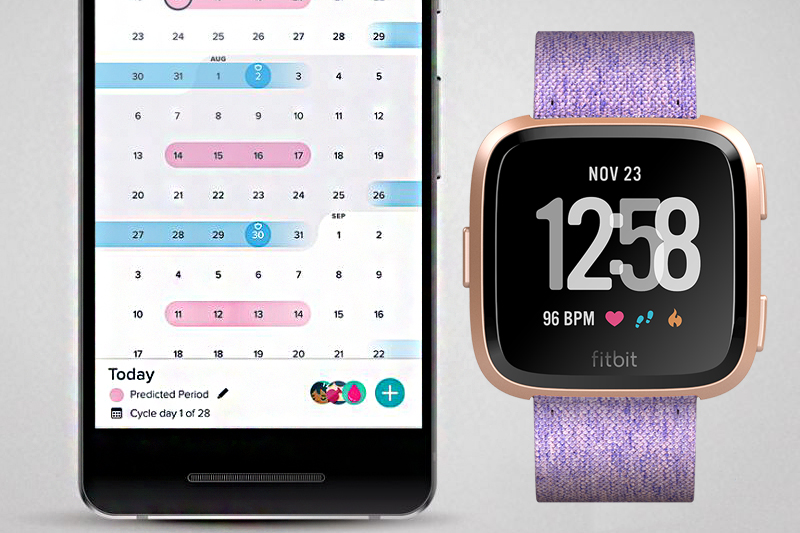 Fast forward to 2018, and Fitbit’s blog posted about women’s health tracking, using the words “menstruation,” “period,” and “sexual health.”
Fast forward to 2018, and Fitbit’s blog posted about women’s health tracking, using the words “menstruation,” “period,” and “sexual health.”
Well isn’t that what we call “real life” stuff?
How time is a tincture and retail health, well, a business recognizing that some demographics (like women committed to health, fitness, stress reduction, mental health promotion, and resilience) have money to spend on high-value and evidence-based products.
So welcome the Versa, one of many women-targeted health tools featured at CES 2019 that are getting real and impactful about women, tech and health. I’ve worn my Versa for about four months now: it’s my first smartwatch-health tracker, having been a decades-committed Skagen stainless steel band analog watch-wearer on my left wrist. On my right wrist, I’ve donned several Fitbit bands, and trackers from Garmin, Withings, Fossil, Jawbone, and others.
[As a sidebar, I’ve gifted all the devices I no longer use to Professor Lisa Gualtieri’s Recycle Health project at Tufts University. Lisa’s team cleans up the donated devices (stripping of data, etc.) and gifts them onto people in the Boston area who can use them. You can do the same with your old tech long stored in “that drawer” by getting a printed label on the Recycle Health website].
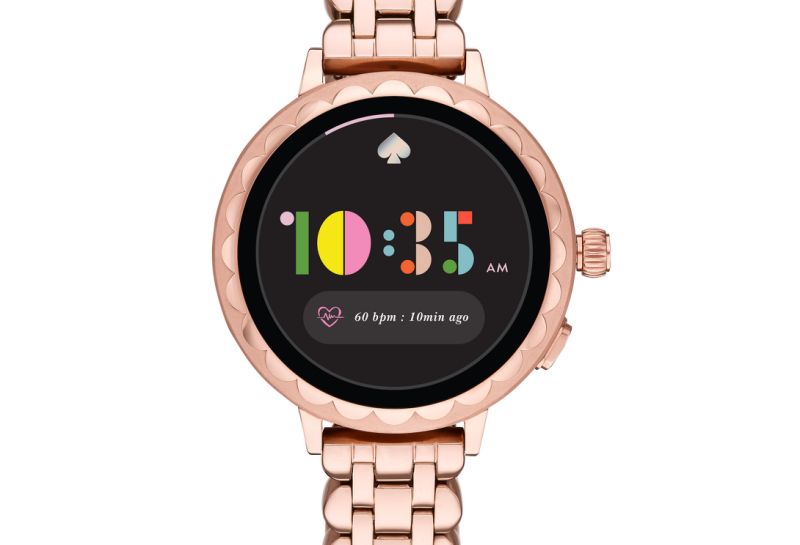 There’s more fashion embedded in technology each year at CES, with brands partnering and licensing their design ethos and personalities to many tech products. One of my personal favorites is Kate Spade, whom we lost in 2018 to suicide (which I covered here in Health Populi as my own sympathy post devoted to her and Anthony Bourdain, may they rest in peace). On a joyful note, Spade’s upbeat design sense lives on in 2019, featuring some adorable watches that track activity. This is among the first fashion brands to incorporate Google’s wearable device software, Wear OS. The watch can track heart rate, has GPS, and can make mobile payments using Google Pay.
There’s more fashion embedded in technology each year at CES, with brands partnering and licensing their design ethos and personalities to many tech products. One of my personal favorites is Kate Spade, whom we lost in 2018 to suicide (which I covered here in Health Populi as my own sympathy post devoted to her and Anthony Bourdain, may they rest in peace). On a joyful note, Spade’s upbeat design sense lives on in 2019, featuring some adorable watches that track activity. This is among the first fashion brands to incorporate Google’s wearable device software, Wear OS. The watch can track heart rate, has GPS, and can make mobile payments using Google Pay.
Health tracking can cover a range of women’s health issues, nothing more intimate and emotionally powerful than fertility and baby-making. This demand has not gone unnoticed in the start-up and financing communities. In 2018, several direct-to-consumer fertility-tech companies garnered $million funding to begin commercializing and scaling their products.
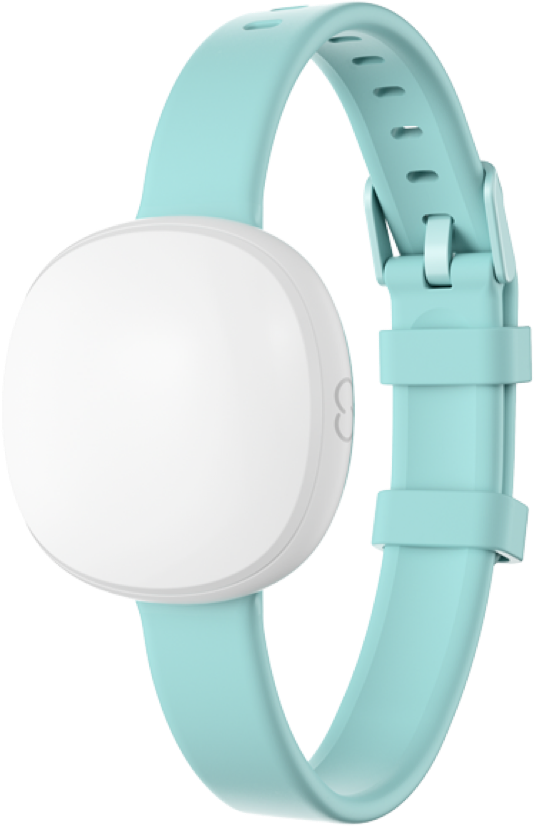 The Ava Fertility Tracker 2.0 is one such innovator, raising a $30mm round of investment in mid-2018. This timing coincided with the announcement of Ava’s 10,000th birth for an Ava user. Ava was founded in Switzerland in 2014 and received the Best of Baby Tech Award at CES 2017. In 2019, the company launches Ava tracker 2.0. This new version replaces traditional basal temperature with pulse rate, skin temperature, and breathing to be more predictive about ovulation. The device runs $299 and bundles in online content and a one-year pregnancy guarantee.
The Ava Fertility Tracker 2.0 is one such innovator, raising a $30mm round of investment in mid-2018. This timing coincided with the announcement of Ava’s 10,000th birth for an Ava user. Ava was founded in Switzerland in 2014 and received the Best of Baby Tech Award at CES 2017. In 2019, the company launches Ava tracker 2.0. This new version replaces traditional basal temperature with pulse rate, skin temperature, and breathing to be more predictive about ovulation. The device runs $299 and bundles in online content and a one-year pregnancy guarantee.
Once pregnant, a woman’s best chance of having a healthy baby is borne out of good pre-natal care. Thanks to Babyscripts, a box of pre-natal goodness, women can self-care during the crucial nine months of fetal development. That box arrives in Mom’s mail and includes a WiFi enabled scale, a blood pressure monitor, an app and content with a warm and informative welcome message. Mom-generated data flows to a HIPAA-compliant platform which informs OB/GYNs about their patients’ progress. For low-risk mothers, BabyScripts can empower self-care and unneeded trips to the doctor. For the clinician, the program benefits workflow, patient engagement, and risk management. I met the co-founders, Anish and Juan Pablo, in 2014 when they were starting up, and since then the company has grown through fruitful partnerships with healthcare providers around the U.S. Babyscripts received a $6mm investment in November 2018 from Startup Health, NueCura, led by Philips whose Mother/Baby unit will partner with the company.
There’s a lot of Baby Tech at CES 2019, an entire track organized by Living in Digital Times. This is a $23 billion business, with 4 million babies born every year. The portfolio of products for baby boggles the mind: when my now-grown daughter was six months old, technology in her room was a baby monitor (walkie-talkie style) and a Diaper Genie (relatively new “tech” at the time). That was 1997. Two decades later, baby tech is app-ified, from tracking feeding and monitoring baby’s room and crib to cooking healthy food for little ones: smart pacifiers, smart baby bottles, GPS-embedded strollers, GPS-bracelets for security…bringing up baby has gotten smart-er.
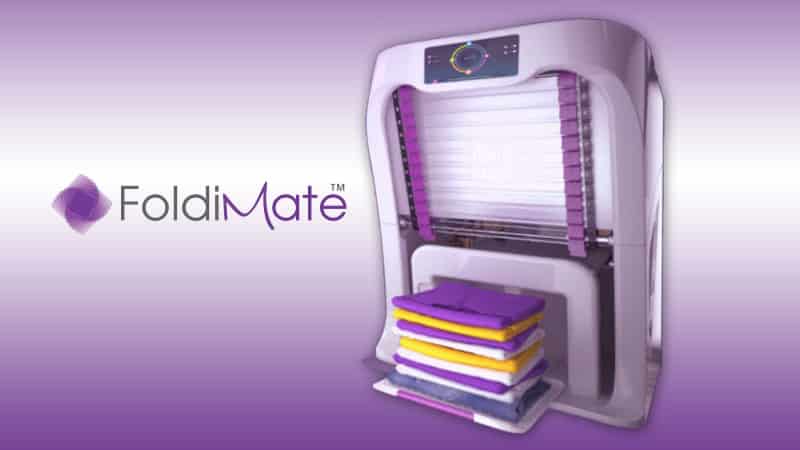 But back to women, and managing everyday life. Women are their homes Chief Household Officers, balancing family, work, volunteer and community activities, friendships, self-health, and home-keeping. For this last and least-enjoyable life-flow, there are connected appliances to help make life easier and more streamlined for managing house tasks. The Roomba, the first such connected home appliance, is now in a mature category, with many competitors for robotic vacuuming. Room-by-room at home, there are offerings at CES ’19 to manage every kind of work-life flow: for cooking, cleaning, washing, drying, and even folding clothes. I met the Foldimate at CES 2018, and am very happy to see it’s back in 2019 and getting market traction. It’s still early days but if tech can help all of us, men and women, save time on home tasks, we can conserve time for family, friends, and alone time to just breathe and think.
But back to women, and managing everyday life. Women are their homes Chief Household Officers, balancing family, work, volunteer and community activities, friendships, self-health, and home-keeping. For this last and least-enjoyable life-flow, there are connected appliances to help make life easier and more streamlined for managing house tasks. The Roomba, the first such connected home appliance, is now in a mature category, with many competitors for robotic vacuuming. Room-by-room at home, there are offerings at CES ’19 to manage every kind of work-life flow: for cooking, cleaning, washing, drying, and even folding clothes. I met the Foldimate at CES 2018, and am very happy to see it’s back in 2019 and getting market traction. It’s still early days but if tech can help all of us, men and women, save time on home tasks, we can conserve time for family, friends, and alone time to just breathe and think.
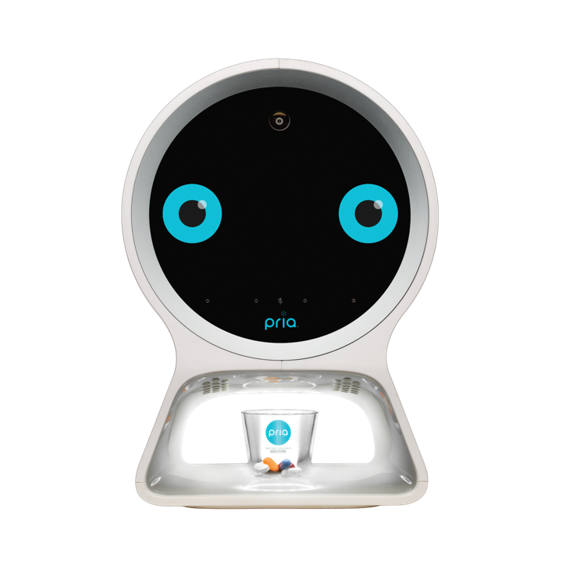 Caregivers tend to be female, and they tend not to have that time to breathe and think: caregivers usually put those they care for first, including their pets (and yes, Pet Tech is also a growing category at CES). It’s encouraging to see that caregivers are called out in many marketing plans for innovations this year at CES. I was particularly keen to meet with folks working in the Stanley Black & Decker (SBD) Future Lab, who have developed the Pria, picture here.
Caregivers tend to be female, and they tend not to have that time to breathe and think: caregivers usually put those they care for first, including their pets (and yes, Pet Tech is also a growing category at CES). It’s encouraging to see that caregivers are called out in many marketing plans for innovations this year at CES. I was particularly keen to meet with folks working in the Stanley Black & Decker (SBD) Future Lab, who have developed the Pria, picture here.
Wait – “Stanley Black & Decker? Aren’t they the folks who make tools and the iconic Dustbuster handheld vacuum?” Yes, indeed. But the company also has a business-to-business reach into healthcare — namely hospitals for security. asset tracking, and climate control. That’s a twenty-year-old business. So it is natural for SBD to consider how to leverage B2B healthcare into the home, where the company has strong consumer brand equity.
Pria wears a lot of hats, as companion, weather forecaster, voice-activated encyclopedia, and first and foremost, medication dispenser. There are other medication management devices available, but Pria incorporates voice-activation that feels like an Amazon or Google assistant experience without the user having to share data beyond meds. The app allows caregivers to be part of the user’s care circle, along with pharmacies and clinicians.
Samsung comes to CES this year with several “bots,” including Bot Care to support caregiving. Bot Care has many uses, including medication management and adherence support, companionship, information channeling (for, say, healthy cooking, nutrition, and exercise), and other functions that make living and aging at home easier and safer. Here’s a short video on Bot Care to learn more.
 Self-care is in short supply among women, who need to take time beyond caring for others. “Put your own gas mask on first” is sound advice for women, who can lead lives wearing so many hats. At CES this year, Procter & Gamble and their Life Lab attended CES as a supplier for the first time. Like Stanley Black & Decker, P&G has a strong consumer brand name, but the initials have never been confused with being a tech company. In the company’s Media Day presentation, I learned that their Life Lab was founded to innovate new products and enhancements to existing ones. They coined their session the “Consumer Experience Show” signifying the company was bringing their deep consumer market knowledge to bear while incorporating technology enhancements to well-known brands like Gillette (for shaving), Olay (for skin care), and Oral-B (for oral care). “We are innovating how we innovate,” they explained, through the Life Lab. Three innovations they presented were:
Self-care is in short supply among women, who need to take time beyond caring for others. “Put your own gas mask on first” is sound advice for women, who can lead lives wearing so many hats. At CES this year, Procter & Gamble and their Life Lab attended CES as a supplier for the first time. Like Stanley Black & Decker, P&G has a strong consumer brand name, but the initials have never been confused with being a tech company. In the company’s Media Day presentation, I learned that their Life Lab was founded to innovate new products and enhancements to existing ones. They coined their session the “Consumer Experience Show” signifying the company was bringing their deep consumer market knowledge to bear while incorporating technology enhancements to well-known brands like Gillette (for shaving), Olay (for skin care), and Oral-B (for oral care). “We are innovating how we innovate,” they explained, through the Life Lab. Three innovations they presented were:
- A new “warm” razor, giving the user the Old School barbershop + hot towel experience;
- The Olay Skin Advisor asks, “what if you could get a personalized skin regimen with one selfie?” which uses the company’s proprietary VizID technology backed by AI and pinpointing personalized skin care routines to fit specific needs; and,
- A new Oral-B Genius X toothbrush, recognizing your “personal brushing style” and providing real-time feedback that is meant to deliver better oral health to the user.
To come full circle, it’s encouraging to note that Gary Shapiro, President of the Consumer Technology Association, announced that CTA would invest $10 million in venture firms that support women and diverse leaders in technology. That’s a welcome commitment from the Association. Now, here’s a video from the first Women in Technology panel ever held at a CES, convened yesterday and sponsored by Lenovo and Intel.




 Interviewed live on BNN Bloomberg (Canada) on the market for GLP-1 drugs for weight loss and their impact on both the health care system and consumer goods and services -- notably, food, nutrition, retail health, gyms, and other sectors.
Interviewed live on BNN Bloomberg (Canada) on the market for GLP-1 drugs for weight loss and their impact on both the health care system and consumer goods and services -- notably, food, nutrition, retail health, gyms, and other sectors. Thank you, Feedspot, for
Thank you, Feedspot, for  As you may know, I have been splitting work- and living-time between the U.S. and the E.U., most recently living in and working from Brussels. In the month of September 2024, I'll be splitting time between London and other parts of the U.K., and Italy where I'll be working with clients on consumer health, self-care and home care focused on food-as-medicine, digital health, business and scenario planning for the future...
As you may know, I have been splitting work- and living-time between the U.S. and the E.U., most recently living in and working from Brussels. In the month of September 2024, I'll be splitting time between London and other parts of the U.K., and Italy where I'll be working with clients on consumer health, self-care and home care focused on food-as-medicine, digital health, business and scenario planning for the future...